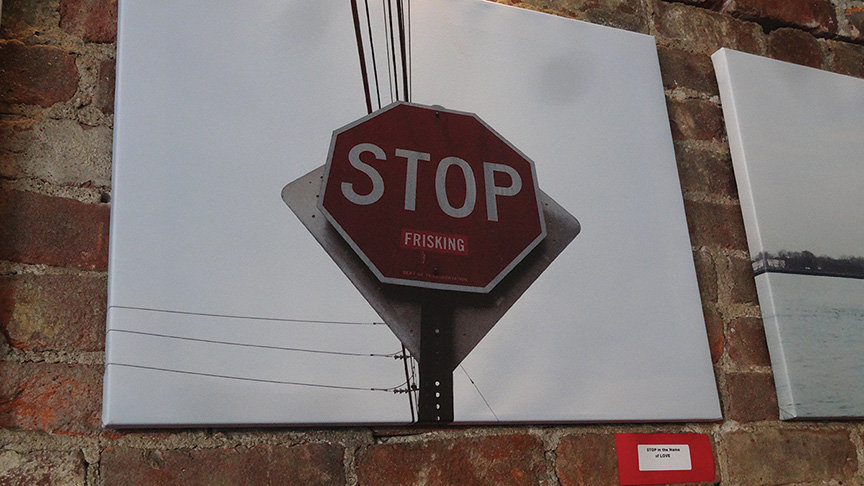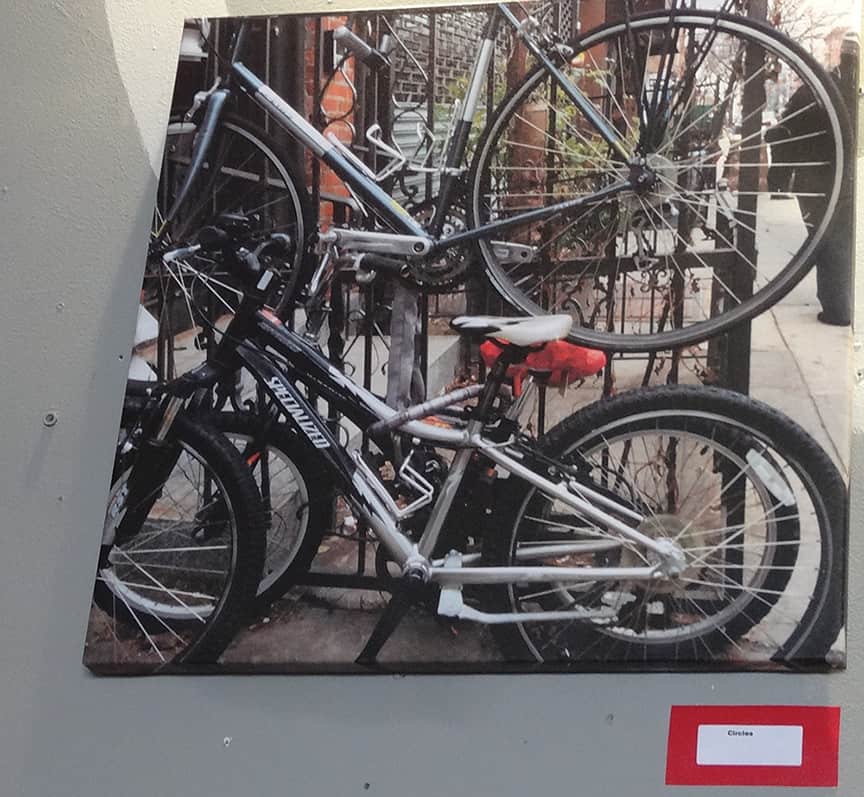
That’s so Brooklyn!
Maram, grabbed my hand and led me over to her favorite photograph hanging on the walls of Hope & Anchor. “Eye Am Watching You,” the photo is entitled. She looked up at me and said, “Chocolate eyes!” She pointed at me, and repeated the phrase.
Her teacher, Ms. Julie Cavanagh explained. We both have brown eyes. Maram giggled.
Maram is part of PS 15 Patrick F. Daly Magnet School’s Academics, Careers and Essential Skills (ACES) program for children with special disabilities. She was there with classmates, teachers, friends and family to celebrate the completion of a project, as well as the opening of her art exhibit, That’s SO Brooklyn.
The ten students in Maram’s class started with a basic question. “Where do you live, and what’s here that is nowhere else?” They set out in small groups to explore the neighborhood and capture photos of anything they thought defined themselves and Brooklyn.
Inspried by exhibit at BMA
The project idea originated out of a current exhibit at the Brooklyn Museum by Judith Scott (1943-2005). Judith was born with Down syndrome, was mostly deaf and could not speak. She spent 35 years in an institution for people with disabilities.
In 1987, her twin sister, Joyce, moved her to Creative Growth Center in Oakland California, a studio art program that fosters and serves artists who have developmental and physical disabilities. Judith began sculptural work after being taught specific textile-based processes.
According to the Brooklyn Museum, “For the next seventeen years, until her death, Scott created extraordinary sculptures assembled from found and scavenged materials wrapped and tied in yarn, thread, and other fibers.” Her exhibit will be on display there through March 29.
Ms. Julie took her students on a class trip to see Judith Scott’s exhibit, Bound and Unbound. “This photography installation marries with the groundbreaking art installation […] and seeks to continue to break down barriers and stereotypes, while furthering the conversation around self-taught artists and the intersection of disability, creativity, and the disability rights movement,” Ms. Julie said.
PS 15’s ACES students are fully included in every aspect of school life in a traditional school experience. Their curriculum is adapted from their respective grade levels with a strong emphasis on arts, projects based learning, and experiences in the community. Students work towards the same standards as their peers, but with specialized support to make everything accessible. The program focuses on not only academics, but also career and essential skills to help students work towards independence, job skills, communication, social skills and mobility.
“Students in PS 15’s ACES classes have intellectual disabilities and have historically been segregated and separated in both school and adult life […] children and adults with intellectual disabilities deserve the same recognition of their individual gifts as their peers and should have full access to sharing those gifts, maximizing their opportunities,” she justified. “What could be more Brooklyn than breaking down barriers and stereotypes, and championing the artist in EVERY child?”
Trek through Red Hook
The journey of That’s SO Brooklyn began with a trek through Red Hook. From the school’s home base on Sullivan Street, the students and teachers spent three hours crisscrossing streets and made their way to Valentino Pier. Along the way, they took more than 70 photos of images that can only be found in Brooklyn “through their lens[es].”
“I think every student took a picture of the blue chair,” Ms. Julie said. “They captured images from their school community that inspired their senses and serve as a visual representation of the borough they call home.”
Back in class, all of the photographs were conglomerated and became a part of the entire group’s collection. Instead of giving credit to individual students, every child got to take credit for all of the pictures. Each photo was rated by the class by a simple thumbs-up or thumbs-down majority.
Once photographs had been chosen, the class discussed the each and assigned a title. “STOP in the Name of LOVE” was another nearly all of the students took. When they discussed what it meant, the kids didn’t know what the “frisking” sticker meant.
Ms. Julie explained the controversial stop and frisk policy to them “in a developmentally appropriate way.” They discussed the importance of respecting police authority, but that some people disagree with the policy.
“I simplified the conversation to what I feel is the important message – that everyone should treat others with love, no matter who they are,” she said. “They all wanted the STOP big in the name [of the photo,] and I said let’s add more. Someone mentioned love, and I said that reminds me of a song.” They chose to capitalize LOVE to balance the capitalized STOP.
Ms. Julie, who sometimes stops with other teachers in to Hope & Anchor for lunches on Fridays, asked Pete Ascolese, owner, about the possibility of exhibiting the photo essay in his restaurant.
Pete eagerly agreed because wanted to “keep [the project] in the neighborhood.” He said he was pleasantly surprised by the artistic quality of the work. “With kids, you never know what you’re going to get. I’m impressed.”
Hope & Anchor was involved in the process by selecting the photos in advance. Bar Manager and Art Curator, Candice Sering went to the school and chose which ones would be on display. She decided where each would hang in the restaurant to determine what size each should be.
On the morning of February 24, Hope & Anchor proudly opened their newest exhibit, That’s SO Brooklyn. Students, who shared credit for the photo essay with all of classmates, individually presented books they had made about where they live at the art opening.
Through the group project and their own presentations, each child learned about the diverse borough they live in. David talked about the tall apartment building he lives in. Charwin learned about one of her favorite places – Coney Island. Ruanny remembered the visit with Ms. Julie and classmates to the Brooklyn Museum. He escorted me to “Blue Chair’” because in Brooklyn, people like to sit down outside.
Restaurant owner Pete’s favorite, “In the Fast Lane” is a scene he sees often – the view of Van Brunt from his store windows. He also likes “Coffee?,” “Blue Chair,” and “Blue Door” as a set because of the complementary colors.
Learning from her students
Even though Ms. Julie is their teacher, she says she learns so much from her students every day. “Lessons of kindness, patience, and love. I learned that perspective is everything – it is the determining factor between a striking photo and just a snapshot, but also it got me thinking more broadly about perspective and its impact on our lives– the way we see ourselves and the way others see us.
“As my students’ teacher I have a role to play in being by their side as they develop and construct their identities, which are not only influenced by their perspective, but by the way others see them. I want everyone they meet to see what I see: able, gifted, talented, loving individuals who have so much to share.”
That’s SO Brooklyn is a photographic essay completed entirely by ACES students at PS 15 with the guidance of their teachers. The students collectively took all photos, ranked their favorites, and named each selected work within class discussions.




The following thirteen pictures will be on display at Red Hook’s Hope & Anchor through the end of March:
- “Brooklyn Berries” – Red berries so big, they almost look like tomatoes on the vine.
- “The Leaves are Sleeping” – The berries in actual perspective in relation to the size of the tree. The tree is winterly barren, but the berries are thriving.
- “In the Fast Lane” – The motion of a skateboarder crossing Van Brunt juxtaposes the idling B61 bus. The image is a direct view from the windows of Hope & Anchor.
- “Circles” – Multiple bicycles chained to an iron gate outside of a residential building create various levels of circles.
- “Coffee?” – An open rusty drain pipe imbedded in the pavement filled with dark, dank water appears looks like coffee in a stained cup. The cracked lip of the pipe even gives the appearance of a handle.
- “Blue Chair” – An aquamarine chair sits on a bespeckled sidewalk against a white contoured wall. The chair is spackled with red and white paint.
- “Blue Door” – A navy blue door set inside an aqua colored frame that complements “Blue Chair” is nestled into a dark brown exterior wall.
- “Trouble Maker” – A graffiti black and white man in a hoodie sits upon a multi-toned red brick wall cradling a sign that reads, “Art is not a crime.”
- “Standing Tall” – Manhattan’s Freedom Tower shoots up into the background sky, while the outer coast of Red Hook plays peek-a-boo in the foreground.
- “STOP in the Name of LOVE” – A stop sign tagged with a “frisking” sticker makes a statement that DOT most likely didn’t intend.
- “Cruisin’ Past Liberty” – A tug tows a barge, “Blak Slee” across Lady Liberty’s waters.
- “Writing on the Wall” – Blue graffiti surrounds rusted iron framed iron windows, while a MLK quote, “Injustice anywhere is a threat to justice everywhere,” is stenciled in a contrasting bright yellow.
- “Eye am Watching You” – The top half of a woman’s face depicts dark, thick eyebrows and a straight-on stare. An iconic Red Hook mural, her “chocolate eyes” are watching.








